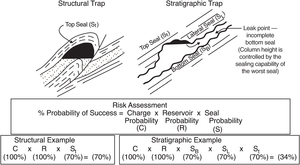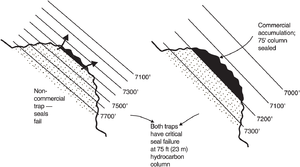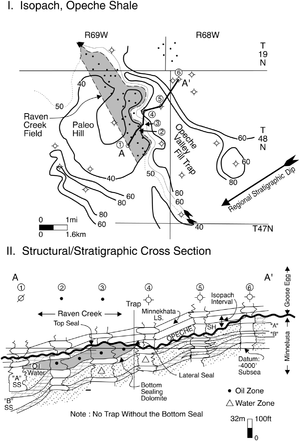Stratigraphic trap seals
| Exploring for Oil and Gas Traps | |

| |
| Series | Treatise in Petroleum Geology |
|---|---|
| Part | Predicting the occurrence of oil and gas traps |
| Chapter | Exploring for stratigraphic traps |
| Author | John C. Dolson, Mike S. Bahorich, Rick C. Tobin, Edward A. Beaumont, Louis J. Terlikoski, Michael L. Hendricks |
| Link | Web page |
| Store | AAPG Store |
Seal geometry[edit]
Most stratigraphic and combination traps require top, lateral, and bottom seals to retain a hydrocarbon accumulation. The figure below compares typical structural and stratigraphic traps and shows why bottom seals are more important to stratigraphic traps in determining accumulation size.
Seal quality and dip rate[edit]
Large stratigraphic traps are most common in basins with gentle structural dip, where small hydrocarbon columns can be areally extensive. As structural dip steepens, the need for high-quality seals increases, raising the probability of trap failure (e.g., .[1] That is why large stratigraphic traps are most common in basins with gentle structural dip, where small hydrocarbon columns can be areally extensive. The figure below illustrates in map view how dip rate affects stratigraphic trap size.
Example[edit]
Raven Creek field (with 40 million BOE) illustrates the importance of a bottom seal. It is a paleotopographic trap in the Powder River basin of Wyoming. An unconformity overlying the “A” sandstone of the Permian Minnelusa Formation determines the primary trap geometry. This unconformity has paleotopographic relief, and the Opeche Shale red beds are sabkha deposits that infill an erosional valley forming the top and lateral seals to the “A” sandstone reservoir. The dolostone bed separating reservoir sandstones “A” and “B” provides the bottom seal.
A trap would not form if the valley fill were composed of porous sand or if the bottom-sealing dolostone were absent (from unpublished data by Ralph Thompson, 1986).
The figure below shows a map and cross section of Raven Creek field.
Reservoir quality and column height[edit]
Because of leaky seals—especially lateral seals—many stratigraphic traps have short hydrocarbon column heights. In these kinds of plays, reservoir quality can be critical. Higher quality reservoirs require less column height to drive water saturations low enough for water-free production. Lower quality reservoirs require more column height for water-free production.
For example, a trap with length::100 ft (32 m) of stratigraphic closure has a maximum column height of length::100 ft. If its reservoir is a mesoporous sandstone with 18% porosity and 10 md permeability, then the bottom length::75 ft (20 m) of the trap will produce both oil and water in a long transition zone. Commercial production can be reached only at the top, where buoyancy pressure is sufficient to create water-free production.
See also[edit]
- Stratigraphic trap basics
- Exploring for stratigraphic traps
- Importance of scale
- Impact of diagenesis
References[edit]
- ↑ Gries, R., Dolson, J., C., Reynolds, R., G., H., 1993, Structural and stratigraphic evolution and hydrocarbon distribution, Rocky Mountain Foreland, in Macqueen, R., W., Leckie, D., A., eds., Foreland Basins and Fold Belts: AAPG Memoir 55, p. 395–425.


